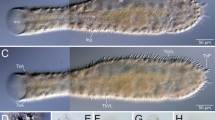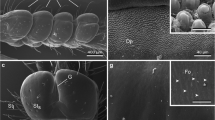Summary
Despite the evident efficiency with which ophiuroids discard their arms, there has been no attempt to understand how the arm is equipped anatomically to achieve and recover from autotomy. A light microscope study of the breakage plane ofOphiocomina nigra revealed a series of features which can be interpreted as adaptations for the process of autotomy. The epidermis splits at a constriction which acts as a pre-determined line of least resistance and which serves to leave lateral flaps for the protection of the retained wound surface. The radial nerve breaks at a level where its cross-sectional area is least and which avoids the ectoneural ganglion; at this point the nerve is attached to the floor of the epineural canal by a collagenous structure which may facilitate its rupture. The lateral compression of the radial haemal canal at the breakage plane is believed to assist its closure after autotomy. The sphincters of the radial water vascular canal are described and it is suggested that since they occur just proximal to the breakage plane, one of their functions may be to seal off the canal after autotomy.
Similar content being viewed by others
References
Anderson, J.M.: Observations on autotomy in the starfish,Asterias forbesi. Biol. Bull. Mar. biol. Lab., Woods Hole111, 297 (1956)
Bauer, K.H.: Funktionmechanismus der Autotomie bei Spinnen (Araneae) und seine morphologischen Voraussetzungen. Z. Morph. Tiere72, 173–202 (1972)
Bellairs, A. d'A.: The life of reptiles, Vol.2. London: Weidenfeld and Nicolson 1969
Christo-Apostolidès, N.: Anatomie et développement des ophiures. Archs. Zool. Exp. Gén.10, 121–224 (1882)
Drury, R.A.B., Wallington, E.A.: Carleton's histological technique, 4th ed. Oxford: University Press 1967
Elder, H.Y., Owen, G.: Occurrence of ‘elastic’ fibres in the invertebrates. J. Zool., Lond.152, 1–8 (1967)
Fontaine, A.R.: The integumentary mucus secretions of the ophiuroidOphiocomina nigra. J. Mar. Biol. Ass. U.K.44, 145–162 (1964)
Hamann, O.: Anatomie der Ophiuren und Crinoiden. Jena Z. Naturw.23, 233–388 (1889)
Humason, G.L.: Animal tissue techniques, 2nd ed. San Francisco: Freeman 1967
Kress, A.: Untersuchungen zur Histologie, Autotomie und Regeneration dreier Doto-ArtenDoto coronata, D. pinnatifida, D. fragilis (Gastropoda, Opisthobranchiata). Rev. Suisse Zool.75, 225–303 (1968)
Lange, W.: Beitrag zur Anatomie und Histologie der Asterien und Ophiuren. Morph. Jahrb.2, 241–286 (1876)
McVean, A.R.: Autotomy inCarcinus maenas (Decapoda: Crustacea). J. Zool., Lond.169, 349–364 (1973)
McVean, A.R.: Autotomy. Comp. Biochem. Physiol.51 A, 497–505 (1975)
Needham, A.E.: The incidence and adaptive value of autotomy and of regeneration in Crustacea. Proc. Zool. Soc. Lond.123, 111–122 (1953)
Pratt, C.W.M.: The plane of fracture of the caudal vertebrae of certain lacertilians. J. Anat.80, 184–188 (1946)
Riggenbach, E.: Die Selbstverstümmelung der Tiere. Ergebn. Anat. Entwickl. Gesch.12, 782–903 (1903)
Sheppard, L., Bellairs, A. d'A.: The mechanism of autotomy inLacerta. Brit. J. Herpetol.4, 276–286 (1972)
Simroth, H.: Anatomie und Schizogonie derOphiactis virens. Z. Wiss. Zool.27, 417–485 (1876)
Smith, J.E.: On the nervous system of the starfishMarthasterias glacialis (L.). Phil. Trans. R. Soc. B227, 111–173 (1937)
Swan, E.F.: Growth, autotomy, and regeneration. In: Physiology of Echinodermata (R.A. Boolootian, ed.), pp. 417–421. New York: Interscience 1966
Teuscher, R.: Beiträge zur Anatomie der Echinodermen. II. Ophiuridae. Jena Z. Naturw.10, 263–280 (1876)
Uexküll, J. von: Die Bewegungen der Schlangensterne. Z. Biol.46, 1–37 (1905)
Wake, D.B., Dresner, I.G.: Functional morphology and evolution of tail autotomy in salamanders. J. Morph.122, 265–306 (1967)
Wilkie, I.C.: A study of the process of ophiuroid arm autotomy. Ph.D. thesis, University of Glasgow 1976
Wilkie, I.C.: Arm autotomy in brittlestars (Echinodermata: Ophiuroidea). J. Zool., Lond. (in press, 1978)
Wilkie, I.C.: Nervously mediated change in the mechanical properties of a brittlestar ligament. Mar. Behav. Physiol. (in press, 1978)
Woodley, J.D.: Problems in the ophiuroid water-vascular system. Symp. Zool. Soc. Lond.20, 75–104 (1967)
Author information
Authors and Affiliations
Additional information
I would like to thank Professor N. Millott for his enthusiastic supervision of my work which was supported by a N.E.R.C. research studentship. I am also indebted to Dr. S.J.F. Gorzula whose herpetological interests first brought my attention to the possibility of analogies between the autotomy planes of lizards and ophiuroids
Rights and permissions
About this article
Cite this article
Wilkie, I.C. Functional morphology of the autotomy plane of the brittlestarOphiocomina nigra (abildgaard) (ophiuroidea, echinodermata). Zoomorphologie 91, 289–305 (1978). https://doi.org/10.1007/BF00999817
Received:
Issue Date:
DOI: https://doi.org/10.1007/BF00999817




